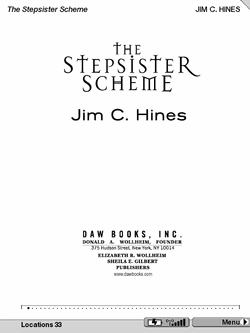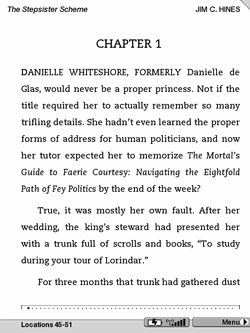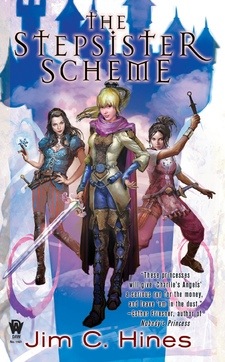Re-incorporating fairytale lore has become something of a cottage industry in the fantasy genre. Often these refurbished pieces are a reaction to the overly sweetened nature of fairytales since the age of Disney (and even before the remaking of Snow White, fairytales were trimmed of their more bloody passages). It’s an interesting base to work from as a writer because there are so many ways to reverse the sensibilities and plots of these stories from childhood.
Story-tellers of all stripes love a good reverse.
In The Stepsister Scheme, Hines takes three fairytale princesses on a semi-traditional sword and sorcery romp: a small, plucky group of heroes picks their way through a dangerous land fraught with supernatural dangers to achieve the quest objective. The adventure is delightful in a light-hearted fashion: there are magic flying horses and wicked stepsisters, fairy king and queen politics, and reveals of the true pasts and abilities of our three princess, which allow them to play their roles in this journey of rescue.
So who are these princesses, their Disneyland versions often decorating girls’ vivid pink accessories?
Cinderella: She hails from the Grimm fairytale involving a dead mother who lives in a tree and advises Cinderella, also providing her with whatever she needs at significant plot points—ball gowns, glass slippers, etc. Like Disney Cindy, she can talk to doves and other animals, who help her; although, because this is classic Grimm, they also wreck bloody unasked-for vengeance on her behalf. At the beginning of The Stepsister Scheme, her well-known story is over, but life goes on: she has to adjust herself to castle life and the politics involved. Seemingly boring .
Until one of her stepsisters shows up with magic at her fingertips in a bold assassination attempt on Cinderella’s life.
Now that’s a disturbing thought.
This disturbance reverberates throughout the story, not simply as the generator of the McGuffin via the kidnapping of Cinderella’s husband, but also as a twisting knife in Cinderella’s psyche: she’s the classic abused child who thought the years-long trial was done, and now has to deal with her abusers returning to her current life, wreaking havoc—even being stronger than before in ways she can’t, by herself, deal with. It’s the nightmare of every former victim of abuse.
Cindy is, aptly so, our every-woman, also receiving a sword of awesome.
Snow White: This being Grimm’s Snow White, all the gory stuff is true, but there’s a twist: the hunter sent to lead her into the forest and kill her fell in love with her, and she with him. After the queen mother discovers his shenanigans with giving her a deer’s heart instead of Snow White’s, she tortures him to death. No wonder after Snow White manages to escape her poisoning (Yeah, I don’t know how that happens in this version. This is something that’s going to come back in any future books in this series) that she takes revenge upon her mother, and what other way can that be but with mirror magic? And thus Snow White becomes the sorceress of the team.
Sleeping Beauty: Her background is given the biggest twist of all. Unlike the others, she is surprisingly of a Middle Eastern heritage. And yet that thing with the killer spinning wheel spindle was always weird, wasn’t it? It’s not so weird if the legend originated with a royal assassination, where the weapon meant to kill Princess Talia was a whip that ended in a spindle-like object. There’s even more disturbing twists in that tale. (Some of it is actually original Grimm.) She escapes far overseas, and with her fairy-gifted skill and grace, becomes a bad-ass assassin.
Trauma-licious. Now that’s Grimm. You’d be surprised if these characters weren’t damaged.
Hines treats these traumatized characters in an apt way: their trauma shapes them, affects them, but is not them. Snow White in particular is more grown-up in this manner than the others, despite seeming more childish, but probably because she actually got revenge and closure. (Very often abuse is never avenged, only escaped. Think about that.) Now Cinderella gets to do it too, except that the business turns out to be messier and less black-and-white than you’d think.
In many ways, Cinderella’s personality is well-drawn and realistic: looking down upon herself is second-nature, and there’s a delicate tenderness to how she interacts with others. At the same time, she learns she can’t take a passive view of the relationship between herself and her abusers. Snow White comments:
“You lived with Charlotte and Stacia for years. But you wanted to think that everything would be fine. That your stepsisters would go off and have their own happy little lives, and you’d spend the rest of your days basking in the warmth of your love, while little birds sang songs of peace and joy . I made the same mistake. The next thing I knew, an old woman was slipping me a poisoned apple.“
All this lies underneath the Princess Bride surface of the story. Very fairytale, save that her journey is the story, rather than simply saving the prince.
I’m not known to be partial to fantasy quest stories of this nature, but I make an exception for The Stepsister Scheme. Strong female characters and realistic treatment of trauma, yo. Which, by the way, has no epilogue to tie things up more neatly, which disappointed me. It’ll probably end up a series, however.
The Kindle Bit
The cover: discreet. Readable. Distinctive. I miss the full-on art but this is a decent compromise. (And yet guys, the Kindle can display graphics, you know.)

Table of contents: lacks a link to a page listing Jim C. Hines’ works (or even just those published by DAW). Otherwise sufficient.
The text: decent indenting, but every paragraph is slightly offset from the others (bigger paragraph spacing than line spacing). It’s okay here, because it doesn’t exceed 1em and introduce horrible whitespace, although it doesn’t help: there’s a reason indenting exists.











